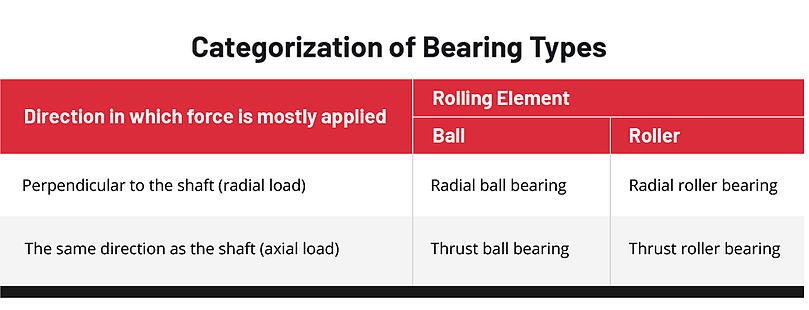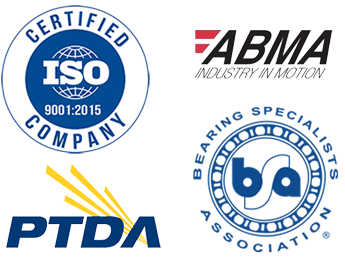Bearings are an essential part of industrial machinery. A bearing's goal is to ensure motion is regulated in a moving part and help reduce friction.
However, there are several types of bearings to choose from, each having its own purpose with its own advantages and disadvantages.
Bearings Manufacturing Company is committed to being a world-class provider for modified and manufactured ball and roller bearing products. Because of this, we have worked with all types of roller bearings in many different applications across all industries.
We thought it would be advantageous to create a series of posts that included the main roller bearings types you may need for your projects. The 5-part series will consist of today's topic—Cylindrical Roller Bearings answers to your cylindrical questions, Spherical Roller Bearings, Tapered Roller Bearings, Needle Roller Bearings, and Cross Roller Bearings.
But first, let's discuss:
Most bearings with a rolling element fall into two broad groups—ball and roller bearings.
Why choose a cylindrical roller bearing over a radial ball bearing?
Cylindrical roller bearings are similar to radial ball bearings in that they are designed to carry a radial load while minimizing friction. Cylindrical roller and radial ball bearings can also handle a small amount of axial loads depending on the application and internal design of the bearings.
In general, roller bearings offer higher load capacities than ball bearings of the same size. The other significant difference between the two bearings is their contact area. For ball bearings, the contact area is a single point where the roller bearings hit a much larger area.
How to choose the correct bearing for your project or application?
When choosing a bearing, you must consider several essential factors. The first factor to consider is the load that the bearing can support—load capacity.
There are two types of bearing loads:
– Radial load: perpendicular to the axis, act as right angles to the shaft (bearing's axis of rotation).
– Axial (thrust) load: parallel to the axis of rotation, acts in the same direction as the shaft. It is considered when the load is parallel to the post.

Source: Koyo, What are the Differences Between Bearings
Each type is designed to support the radial or axial load.
If you require a bearing that needs a high radial load, a cylindrical roller bearing is recommended.
The key takeaway:
Know the amount of bearing load your application requires when deciding the best bearing for the job. Typically smaller/lighter loads work best with ball bearings, and heavier load applications work best with roller bearings.
Onto cylindrical roller bearings and why you might need them . . .
What are cylindrical roller bearings, and why choose them?
The cylindrical roller bearings have a high radial load capacity and are suitable for high speeds. They are in linear contact with the raceways. They are designed to be reliable and a good fit for the environment.
The bearing is highly versatile and can be used for many applications. There are several different types of cylindrical roller bearings on the market.
They vary according to the number of rows of rollers (usually one, two, or four) and if there's a cage or not. No cage allows for the bearing to have more rows, which helps support even heavier radial loads. [source]
These types of bearings are commonly used in rotary applications.
Cylindrical roller bearings can support significant radial loads (even very significant ones).
Advantages: Long bearing life, support significant radial loads, robust
Disadvantages: Cannot tolerate high axial loads.
Cylindrical roller bearings can take some axial load in one direction when the inner or outer rings have two ribs.
Double-row cylindrical roller bearings have high radial rigidity and are used primarily for precision machine tools.
Summary: What are the significant benefits of cylindrical roller bearings?
- Greater radial load capacity compared to ball bearings
- The roller design accepts faster speeds than other types of roller bearings
- Resist damage from fatigue
- Have straight outside and inside diameters (can also be tapered)
- Flush inside the housing
- Easy to install, which reduces potential installation damage
- Slim, saves space and weight
- Comes in several sizes and materials
Here's an image of our black oxide cylindrical roller bearing . . .
What applications are cylindrical roller bearings used for?
Cylindrical roller bearings are used in a variety of applications. Common cylindrical bearing uses include:
- Mining
- Power generation/Wind turbines
- Power transmission
- Machine tool
At BMC, we can modify Cylindrical roller bearings for
- Radial internal clearance changes (Ex: C3 to C4)
- Adding lube groove and holes to outer and inner races
- Custom rotation slots and keyways
- Lifting holes
- Changing from a straight to taper bore
- Applying special coatings
- and more
Listen to Joe, our modifications specialist, as he goes into depth about the specific modifications we can do at BMC . . .
In Closing
At BMC, you get a one-stop solution for your bearings needs, including modification, manufacturing, and repair.
We've helped distributors and manufacturers worldwide get the bearing and power transmission products they need.
Talk to one of our bearing experts today to tell us what you need, and we can help you get started.
p.s. Stay tuned for our Spherical roller bearings post next—if you need a bearing that can handle heavy radial loads, severe misalignment, and some axial loads in either direction.

.png)



